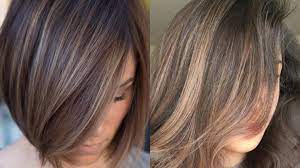
Lowlights offer an alternative to highlights in that they use a demi-permanent or permanent dye to lighten hair color without using bleach; in fact, lowlights may even help cover grays more effectively! If you have natural light blonde hair, try adding subtle sandy brown lowlights for a striking, sun-kissed effect.
Blondes
Blonde hair can benefit from many highlighting techniques, and lowlights are one such choice. By dyeing some strands darker than your base color and creating contrast and depth through lowlighting strategies, lowlights add dimension and contrast that helps add visual interest and depth. Furthermore, this technique works wonders on flat blonde locks requiring added dimension!
Strawberry blonde, an amalgamation of red and blonde hues, pairs beautifully with brown lowlights that add natural depth. This shade can also be worn warm or cool, depending on which combination is chosen, so experiment until you find your ideal look!
Ice blonde is a highly light shade that’s easy to maintain and wear, either warm or cool, and pairs beautifully with silver-gray lowlights for a trendy, modern appearance. Ice blonde can serve as a quick way to refresh your blonde locks without committing a full root touchup.
Brunettes
Brunettes typically possess more of the eumelanin natural hair pigment, making them better equipped to wear any shade they please; however, over-saturated colors like blue or magenta could overpower their complexion and be too bold for their face.
Brunettes can sport the trendy light-to-dark fade look known as an ombre, which features dark roots with bleached ends or subtle variations such as gradual light-to-dark fades known as sombres.
A beautiful brunette lowlight shade has golden or caramel tones, giving your strands a soft, natural-looking glow. Additionally, this style can easily be maintained using sulfate-free shampoo and conditioner designed specifically for color-treated hair – helping prevent its color from quickly fading over time and giving a chic yet elegant appearance that won’t change drastically over time. A long solid-colored maxi dress pairs beautifully with this style for an eye-catching ensemble and is also an easy way to switch up their style without making drastic changes.
Redheads
Redheads possess an irresistibly charming and captivating allure that instantly sets them apart from other races. Redheads are an alluring species with undeniable beauty that only gets more striking with age. If you’re born this way or opt to dye your locks red by choice, try adding subtle golden blond lowlights – they’ll blend nicely with your existing red base color for an entirely natural-looking result!
Dark copper lowlights will give your red hair an eye-catching twist, providing dimension and definition with just the right shade of burgundy. This look works wonders on straight or curly locks. Perfect for anyone wanting to keep their red hue fresh and lively, Riverdale actress Madelaine Petsch proudly wears natural reddish locks. In contrast, Mad Men actress Christina Hendricks epitomizes timeless ginger bombshell status. This may be needed if your locks have medium to deep red hues!
Copperheads
Copperhead snakes are one of the more commonly-seen yet underrated venomous serpents, often overlooked due to their intimidating name. Yet despite this reputation, these serpents rarely attack humans except when cornered or harassed; plus, they’re the easiest venomous species to keep as pets.
They are opportunistic feeders, devouring mice, birds, lizards, salamanders, frogs, toads, and insects like grasshoppers and cicada nymphs before swallowing them whole. Their venom helps kill their prey before eating.
Like other pit vipers, copperheads are oviparous (they lay eggs that develop inside their bodies). Once expelled from their female’s body, young copperheads resemble adults but feature yellowish tail-tips.
Copperhead snakes utilize their heat-seeking pits to locate prey animals lying motionless on the ground or in dense vegetation and using their “heat-seeking” holes. Their “heat-seeking” pits help them pinpoint prey quickly. Their “wriggling green caterpillar” tail may even mislead the target into believing they are harmless insects – all so the copperhead can grab and devour its prey whole before slowly discharging from its coil.

